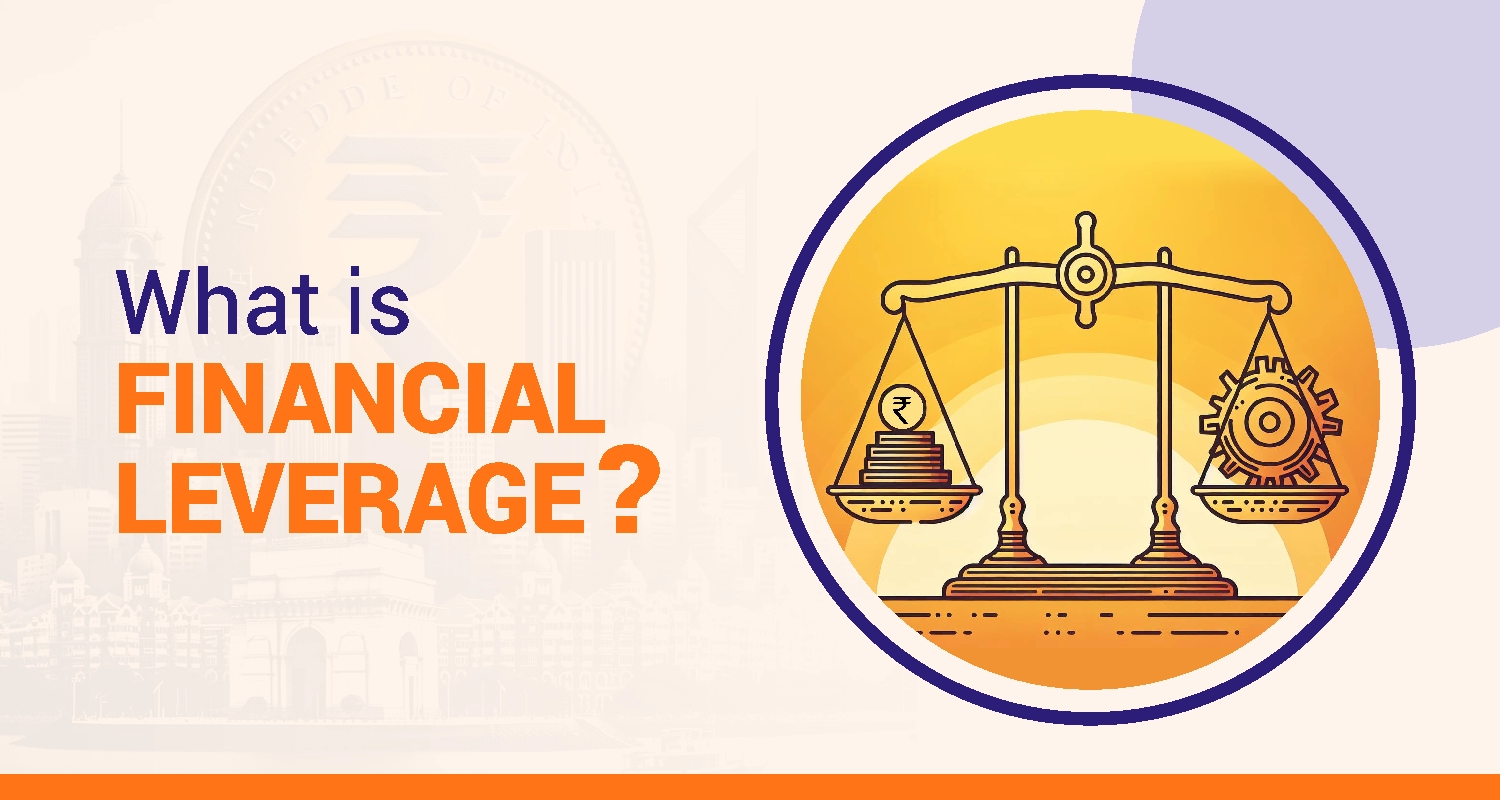What is Financial Leverage? Types & Potential Risk Explained

You remember one of the older generation’s security advice: gold will keep you secure. What they meant was gold is an asset that you can leverage anytime and every time you need money. Whether it is funding your business idea or personal emergencies, you can get a loan against the gold, or in other words, you can leverage your gold asset. There are similar practices in business that help them acquire capital at short notice. What are these, and what are the different types of leverages? Let’s understand keeping more focus on financial leverage in financial management.
What is leverage?
Leverage is when you borrow money for a specific purpose, with the promise to repay it with interest over time. The goal is to help you achieve a higher return with less of your own investment. For example, a small retailer might use a Rs.5,00,000 line of credit to buy extra inventory for the holiday season. This allows them to stock popular items, boost sales by 30%, and earn enough profit to comfortably repay the loan while increasing their overall revenue. The importance of leverage is highlighted in businesses that aim to grow beyond their existing capital. However, it’s important to weigh the risks and potential returns before taking on debt.
Types of leverage:
There are three main leverages that companies use:
- Financial leverage is when the company uses borrowed money, like loans or bonds, to increase returns on investments. The idea is that the returns from the investment will be more than the cost of borrowing. For example, if a company borrows money to buy a new factory and expects the factory to generate more income than the interest on the loan, that’s financial leverage.
- Operating leverage involves using fixed costs, like rent and salaries, to increase returns. The company spends on these fixed costs to produce goods or services, hoping that sales will generate enough revenue to cover the expenses. A simple example is renting a factory and hiring employees to make products, expecting the sales revenue to cover those costs. The formula for computing this is: Operating leverage = fixed cost / total cost.
- Combined leverage is when both financial and operating leverage are used together. This means the company uses borrowed money and fixed costs to boost returns. An example of combined leverage is when a company rents a factory, hires employees, and also borrows money to buy a new factory. The aim is that revenue from both fixed costs and debt will outweigh the expenses. Mathematically: Combined leverage = financial leverage x operating leverage
How does financial leverage work?
Let’s understand the mechanism through an example. When a company purchases assets, it has three financing options: equity, debt, or leases. Debt and leases usually come with fixed costs lower than the income the company expects from the asset. Let’s focus on debt financing for asset acquisition.
Imagine Company Y wants to buy an asset worth Rs.2,00,000. The company can either use equity or debt financing. If it chooses equity, it will own the asset outright with no interest payments. If the asset increases in value by 20%, its new value will be Rs.2,40,000, giving the company a profit of Rs.40,000. On the other hand, if the asset depreciates by 20%, the value drops to Rs.1,60,000, resulting in a Rs.40,000 loss.
Now, let’s say the company decides to finance 50% with common stock and 50% with debt. If the asset’s value rises by 20%, its new value will be Rs.2,40,000. After repaying the Rs.1,00,000 debt, the company will have Rs.1,40,000 left, earning a Rs.40,000 profit. However, if the asset depreciates by 20%, the value becomes Rs.1,60,000. After paying the Rs.1,00,000 debt, the company is left with Rs.60,000, leading to a Rs.40,000 loss (Rs.1,00,000 – Rs.60,000).
Sapna aapka. Business Loan Humara.
Apply NowFinancial Leverage Formula:
One way to assess your business’s financial leverage is to use the debt-to-equity ratio. This ratio indicates how much of your assets are funded by debt versus shareholders’ equity.
As per the debt-to-equity ratio, the financial leverage is calculated as
Financial leverage ratio formula = Average total assets / Average total liabilities
For example, if your total assets this year are Rs. 8,00,000 and last year they were Rs. 6,00,000, your average total assets would be: (8,00,000 + 6,00,000)/2 = Rs.7,00,000
You calculate average total equity in a similar way. Let’s say your balance sheet looks like this:
|
ABC Balance Sheet (Rs.) |
2023 |
2022 |
|
Assets |
8,00,000 |
6,00,000 |
|
Liabilities |
2,00,000 |
1,00,000 |
|
Equity |
6,00,000 |
5,00,000 |
The calculations would be:
- Average total assets = (8,00,000 + 6,00,000) / 2 = Rs. 7,00,000
- Average total liabilities = (2,00,000 + 1,00,000) / 2 = Rs. 1,50,000
- Financial leverage ratio = 7,00,000 / 1,50,000 = 4.67
A ratio of 1 means no leverage. The higher the ratio, the more leveraged and riskier your business becomes. Here, a financial leverage ratio of 4.67 means your business is heavily leveraged. This indicates that for every Rs. 1 of equity, you have Rs. 4.67 in assets, most of which are financed through debt. In simple terms, your business is using a significant amount of borrowed money to fund its operations or growth. Learn what is meant by business risk.
Measures of financial leverage:
The debt-to-equity ratio isn’t the only formula or ratio to compute financial leverage. Multiple other ratios can be used to gauge the magnitude of financial leverage. The ratios include-
- Total-Debt-to-Total-Assets Ratio:
This ratio shows how much of a company’s assets are funded by debt. You calculate it by dividing total debt by total assets. The formula is:
Total-Debt-to-Assets Ratio = Total Debt ÷ Total Assets.
- Debt-to-EBITDA Ratio:
EBITDA stands for Earnings Before Interest, Taxes, Depreciation, and Amortization. This ratio helps assess if a company’s debt compared to its income is manageable. A high debt-to-EBITDA ratio indicates the company is carrying more debt than it earns. The formula is:
Debt-to-EBITDA = Total Debt ÷ EBITDA.
- Equity Multiplier:
This ratio helps to understand how much of a company’s assets are financed by equity. A low equity multiplier means the company relies more on equity than debt. The formula is:
Equity Multiplier = Total Assets ÷ Total Equity.
- Debt-to-Capitalization Ratio:
This ratio compares a company’s debt to its total capitalization. It helps measure the level of risk a company takes to increase profits. The formula is:
Debt-to-Capitalization = Total Debt ÷ (Total Debt + Shareholder Equity).
- Degree of Financial Leverage (DFL):
This ratio measures how sensitive a company’s earnings per share are to changes in its operating income. A higher DFL means greater leverage. The formula is:
DFL = Percentage Change in EPS ÷ Percentage Change in EBIT.
Advantages and Disadvantages of Financial Leverage:
- Advantages of financial leverage:
The importance of financial leverage is highlighted in the ability of business owners and investors to boost their profit margins. They can earn higher profits by using borrowed money alongside their initial capital. This strategy enables them to access more expensive and potentially better investment options. Moreover, you don’t lose any equity control or decision-making power with financial leverage.
- Drawbacks of financial leverage:
However, financial leverage comes with significant risks. It can lead to substantial losses, sometimes exceeding the initial capital invested. Therefore, investors must have a clear understanding of their financial situation and the investment choices they are considering.
Risks of Financial Leverage:
One of the impacts of financial leverage is risk to the company. Financial leverage can boost a company's earnings, but it also carries significant risks. If interest payments on borrowed funds exceed the returns from an asset, the company may face losses. This situation can happen when asset values drop or interest rates increase unexpectedly.
- Volatility of Stock Price:
High financial leverage can cause profits to fluctuate widely. As a result, a company's stock price may experience frequent ups and downs. This volatility complicates the proper accounting for stock options held by employees. Rising stock prices can also lead to higher interest payments to shareholders.
- Bankruptcy:
Businesses with low barriers to entry tend to see more revenue and profit fluctuations compared to those with high barriers. Such fluctuations can push a company toward bankruptcy, especially if it struggles to meet its growing debt obligations and operating costs. If debts go unpaid, creditors may resort to bankruptcy court to auction off the company’s assets to recover their money.
- Reduced Access to More Debts:
When lending to companies, financial institutions closely examine their level of financial leverage. Companies with a high debt-to-equity ratio find it harder to secure additional funding due to the increased risk of default. If lenders do choose to provide loans to these highly-leveraged firms, they often charge higher interest rates to offset the risk involved.
Bottomline:
When used correctly, financial leverage can be a powerful tool for companies. It helps them boost returns on investments and grow faster without diluting the control of current shareholders. However, there are significant risks involved. If a company cannot generate more profits than the cost of borrowing, it may face financial problems, damage to its reputation, or even bankruptcy. Because of this, it’s essential for companies to evaluate the viability, profitability, and risks of new investments before they commit to debt financing.
FAQs:
Q1. What Is a Good Financial Leverage Ratio?
Ans. A debt-to-equity ratio over one means a company has more loans than shareholder funds. A higher ratio indicates more debt, which means higher risk. However, a good ratio can differ by industry and company. To determine if a ratio is good, compare it to similar companies in the same industry or look at the company’s past financial performance.
Q2. Why does the need for financial leverage occur?
Ans. Financial leverage arises because of a company’s need to finance its growth projects, amplify returns, and multiply its buying power.
Q3. What are the advantages and disadvantages of leverage?
Ans. Leverage boosts the power of every dollar you invest. Leveraged finance is even stronger, but it comes with risks. If a business takes on too much debt, its leverage can become excessive, increasing its risk exposure.
Sapna aapka. Business Loan Humara.
Apply NowDisclaimer : The information in this blog is for general purposes only and may change without notice. It does not constitute legal, tax, or financial advice. Readers should seek professional guidance and make decisions at their own discretion. IIFL Finance is not liable for any reliance on this content. Read more



